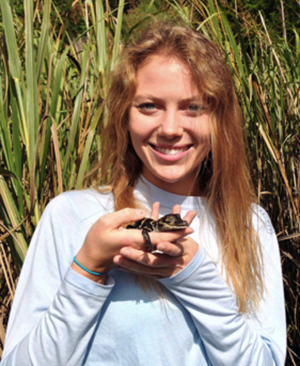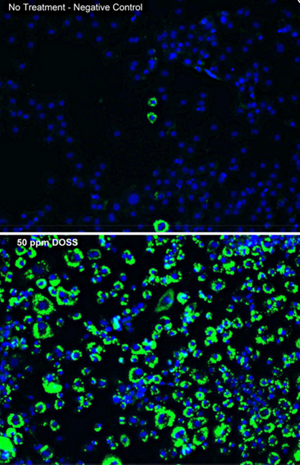
Lexi poses with a baby alligator during an alligator release trip. Other graduate students Lexi works with treat alligator eggs with mixtures of oil, Corexit, and other environmental contaminants to assess their effects on development. Lexi enjoys taking a break from the lab to help on release and egg collection trips. (Provided by: Lexi Temkin)
Unhealthy diet and inactivity are the first things that people think about that cause obesity.
However, Alexis Temkin is finding an unexpected potential contributor to increased fat cell production: a component in dispersants used for oil spill cleanup and many personal care products. She is excited to share her stories about the scientific detective work that is unfolding right now.
Lexi’s research melds medicine and marine science to help researchers and doctors better understand the impacts of oil spill compounds on the determination of human cell type. She hopes to influence the way chemical safety is approached, “Our group wants to improve testing for sublethal effects, such as fat cell production rates, when assessing certain chemicals. It’s a different way to think about safety and health.”
Lexi is a marine biomedicine and environmental sciences Ph.D. student at the Medical University of South Carolina and a GoMRI Scholar with the project Using Embryonic Stem Cell Fate to Determine Potential Adverse Effects of Petroleum/Dispersant Exposure. She shares her scientific journey and the places it could take her.
Her Path
Lexi’s story begins as a child who always enjoyed learning about the natural world. She describes herself as “that kid on the beach who would pick up all the bugs and fish” and gravitated toward science classes, particularly marine science and human health. Her varied interests made it challenging to answer every high school student’s least favorite question: what do I want to be when I grow up? While Lexi’s first instinct was to become a doctor, she could not shake her interest in marine science. She found ways to study both subjects as an undergraduate at Connecticut College. The more courses she took, the more she realized her true calling. “I genuinely liked medicine, but I became more interested conducting research than treating patients,” she says. “I think ‘be a doctor’ was an easier answer when I was a teenager than ‘be a research scientist’ because at that age you don’t really think of research as a career.”
While studying abroad at James Cook University in Australia, Lexi learned about marine biomedicine, which examines the potential of natural marine products to treat human diseases. It was the perfect marriage of her two major interests. She was able to get hands-on experience at the Harbor Branch Oceanographic Institute through Florida Atlantic University’s Summer Internship Program, researching how natural products isolated from bacteria in marine sponges could inhibit cell proteins associated with pancreatic cancer. Knowing this was the field for her, Lexi enrolled in the Medical University of South Carolina’s Marine Biomedicine and Environmental Sciences graduate program. There, she met Dr. Demetri Spyropoulos who had just begun GoMRI research on the molecular-level effects of oil and Corexit exposure on human health. “Since the grant had just started, we could ask a lot of different questions and watch the story unfold,” says Lexi. “It’s a very discovery-based science, and I love that.”
Her Work

Images were taken from the fluorescent microscope Lexi used to measure the “fatness” of cells. She stained the cells with different colors of fluorescent dyes, which bound to the cell’s triglycerides or nuclei. Computer software linked to a fluorescent microscope counted the photons given off by the dyes to count cells and triglyceride levels. Here, cell nuclei are indicated by blue light and triglycerides are indicated by green light. These images depict cells with no exposure to oil or dispersant (above) and cells exposed to DOSS (below). (Provided by: Lexi Temkin)
Lexi’s study searches for compounds in crude oil, dispersed oil, and Corexit dispersant that can act as obesogens. Obesogens are chemicals that encourage stem cells to become fat cells by activating a receptor (fat cell differentiation). Previous and current research has shown that environmental exposure to certain chemicals (obesogens) can alter gene expression and cause fat cell differentiation. Lexi is using cell-based tools to ask if certain fractions of crude oil, dispersed oil, or dispersant contain obesogens.
Lexi refers to the detective part of her research as a “fishing expedition,” during which she devoted her energy to searching for possible obesogens among the many chemicals contained in oil and Corexit dispersant. One of her cell-based tools used bioluminescent transcription assays to help identify obesogen chemicals. She found that only cells in mixtures containing Corexit exhibited receptor activation. An assessment of the dispersant’s components narrowed her search to DOSS – a major component of Corexit formulations.
With this new information, Lexi used another cell-based tool to see how different DOSS concentrations drove fat cell production. She explained that you can actually see the cells increase in triglycerides and gain lipid droplets as they differentiate into fat cells. She measured the cell’s triglyceride levels and found that cells exposed to more DOSS were indeed “fatter” than those that had less or no DOSS exposure. Lexi and her team are collaborating with epidemiologists focused on human exposure to the Deepwater Horizonoil spill to identify biomarkers of DOSS exposure in human stem cells, humans, and mouse and alligator animal models.
Lexi is confident about the impact her research could have on preventative medicine. Information about the ways certain chemicals impact human health can help people make lifestyle choices that reduce their exposures and could even counteract negative effects. “Some people might see these findings as doom and gloom, but knowing the risks of exposures and how to avoid them should be empowering!”
Our partners at the Smithsonian Ocean Portal featured Lexi and her research in honor of Women’s History Month.
Her Learning
Lexi’s GoMRI experience has taught her the importance of being open-minded and communicating with other researchers. She encourages talking to people outside of one’s field, because they may offer a new perspective to your work. “I’d never worked with oil before, and we were unsure how to dose our cells,” says Lexi. “However, when we talked to people who work with oil and dispersants every day, they knew exactly which methods we should use and which mixtures to make.” Lexi emphasized the value of events like the Oil Spill and Ecosystem Science Conference. “GoMRI does an amazing job connecting different scientific communities and keeping everyone informed of what each other is doing,” she explains. Researchers from many different fields and backgrounds are brought together. It’s an incredible environment to work in, and I’m thankful for that.”
One of Lexi’s favorite memories is the moment she realized her research could improve not only our understanding of safer oil spill cleanup, but also medical practices. She and her team often collaborate with Reproduction, Endocrinology, and Childhood Health (REACH) – a research group studying environmental effects on children’s health. She presented a lecture explaining how embryos could develop a predisposition to obesity due to chemical exposure in the womb and detailing her DOSS research. A physician in the audience mentioned that doctors often prescribe laxatives containing DOSS to pregnant women, opening Lexi’s eyes to the potential scope of her research. “When we started our research, we didn’t know where this story was going to go,” reflects Lexi. “Human exposure to DOSS through an oil spill may generally be minimal, but if you’re a pregnant woman your exposure could come from many different sources. It was another moment when just talking to people could make this a completely different story.” Working with the REACH group, Lexi plans to compare fat levels and molecular markers in children whose mothers did and did not take these laxatives while pregnant.
Her Future
Lexi aims to complete her Ph.D. by the end of 2016. After graduation, she wants to get involved with education and community outreach opportunities in her field to help communicate knowledge about environmental exposures and their contributions to disease. “I think a lot of the science is out there, but people don’t know about it,” she says. Lexi is also interested in becoming a professor and teaching at the undergraduate level.
Reflecting on her journey, Lexi offered some advice for those considering a career in science. “It’s really easy to change fields, especially when you’re young. Trying different things is a good way to figure out what you want to do,” says Lexi. “Just because you do one type of research in college, it doesn’t mean that you’re locked into that one thing.” She encourages students who are curious about research to approach their professors and ask if they can get involved in on-going studies, “If you have even the slightest bit of interest in something, pursue it.”
Praise for Lexi
Lexi’s advisor, Demetri Spyropoulos, is enthusiastic about her potential as a scientist and researcher. He explained that Lexi stands out from other graduate students due to the innovation and exciting possibilities behind her project. “A mixture of sea water, Corexit, and Gulf oil is an incredibly complex mixture of components,” he explained. “It’s quite astounding that Lexi could determine that there was a potential ‘obesogen’ in the mix and be able to zero in on a single component.” He also noted that Lexi’s DOSS research has and will benefit greatly from her people-person skills, “We use some very sophisticated equipment and technologies, and Lexi is just as at home in these settings as she is when she’s getting news reporters and students excited about her project’s potential.”
Spyropoulos is proud to note that Lexi has not only done some great research, but also “brought it to a point at which they can ask some tough questions of safety: whether there are lasting impacts of exposure and, if so, what doses/exposures cause these impacts.” He explained that she can look for persistent DOSS-specific changes that identify people who have been exposed, the extent of their exposure, and impacts on their health. “She really wants to make a positive mark in this world and help the life in it,” he said. “And she’s running on all cylinders to make that happen.”
The GoMRI community embraces bright and dedicated students like Lexi Temkin and their important contributions. TheGoMRI Scholars Program recognizes graduate students whose work focuses on GoMRI-funded projects and builds community for the next generation of ocean science professionals.
Visit the department website to learn more about their work.
************
This research was made possible in part by a grant from BP/The Gulf of Mexico Research Initiative (GoMRI) to the Using Embryonic Stem Cell Fate to Determine Potential Adverse Effects of Petroleum/Dispersant Exposure. The GoMRI is a 10-year independent research program established to study the effect, and the potential associated impact, of hydrocarbon releases on the environment and public health, as well as to develop improved spill mitigation, oil detection, characterization and remediation technologies. An independent and academic 20-member Research Board makes the funding and research direction decisions to ensure the intellectual quality, effectiveness and academic independence of the GoMRI research. All research data, findings and publications will be made publicly available. The program was established through a $500 million financial commitment from BP. For more information, visit http://gulfresearchinitiative.org/.
